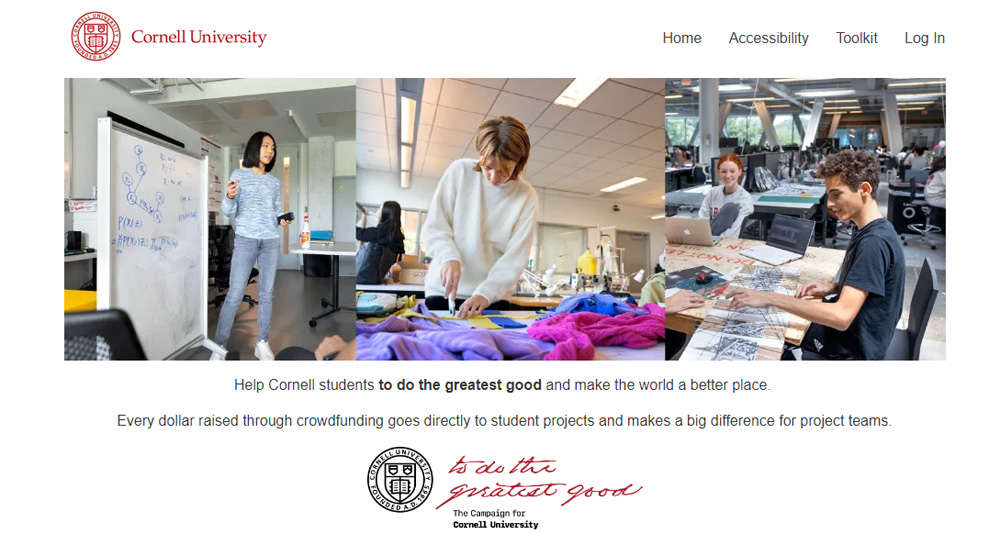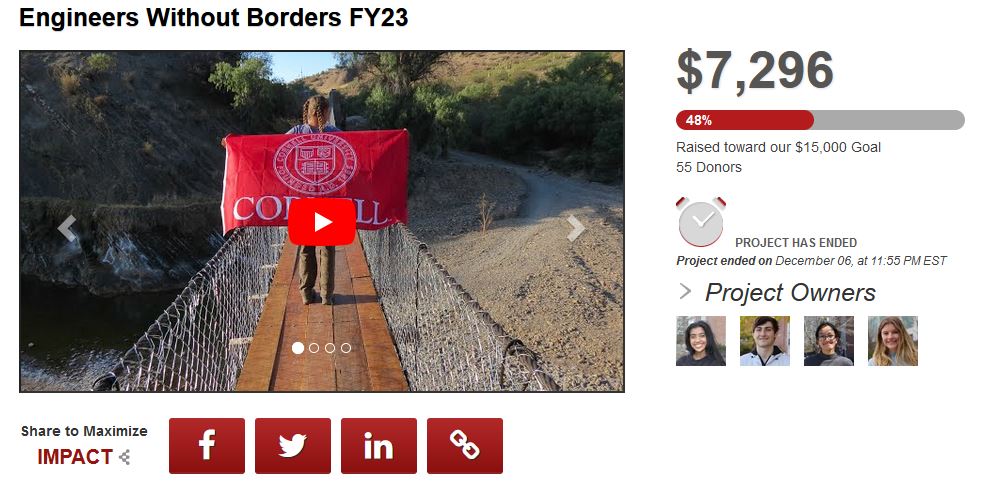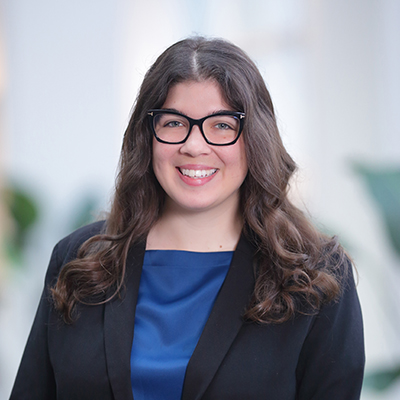fundraising
How Cornell University Engages Donors With Cause-Based Crowdfunding “To Do the Greatest Good”
Establishing a new charitable crowdfunding program at your institution can be intimidating. You are tasked with things like building a web platform, working with advancement services to find a way to accept payments, creating an application for project proposals, and educating project teams. When you are just starting, many people involved will be brand new to fundraising. It’s a big, challenging task.
This summer, the RNL ScaleFunder consultant team has been working with our partners across the country to build up crowdfunding cycles: streamlining the crowdfunding process to yield better results for project teams, increase bandwidth for annual giving staff, and make the donation process as simple as possible for crowdfunding donors.
Several long-time RNL ScaleFunder Crowdfunding partners have spent this summer re-vamping their training modules, brainstorming creative project ideas, and strategizing ways to better engage and retain donors.

One such institution, Cornell University, has been a power user of the RNL ScaleFunder Crowdfunding platform since 2013, raising more than $5 million in support of a wide variety of projects. Jon Gregory, associate director for donor participation and special projects for Cornell Alumni Affairs and Development, joined us to share his “tricks of the trade” for keeping things fresh and why he, as the leader of this powerful program, feels that crowdfunding is a crucial part of the fundraising landscape in a modern advancement and alumni shop.
Can you share some insight on how Cornell builds and retains project teams?
Jon: We love to maintain the involvement of our usual suspects: student orgs and project teams that have a yearly case for funding. These groups are able to build loyal donor bases and maintain a level of consistency conducive to great fundraising by having the same group of students involved for several years. However, as much as we like to support this sustained success, we get excited to welcome new groups every year and help make an impact or reach a group of donors that otherwise wouldn’t be possible without Cornell Crowdfunding.
What does the ‘Cornell Crowdfunding Model’ look like?
Jon: We actively recruit our internal Crowdfunding Team members throughout the year. We have built our team in a way that is inclusive of all corners of our division, not just staff dedicated to fundraising roles. This allows us to use our Crowdfunding Team as a professional development opportunity for staff, allowing folks to try something new, learn more about fundraising, and get the opportunity to do student- and alumni-facing work they may not otherwise have the chance to do in their day-to-day role. Our model has long been to support project teams through a central Alumni Affairs and Development Crowdfunding team. After a Crowdfunding application has been accepted and approved, project teams are paired with a liaison from our Crowdfunding Team. This liaison is there to answer questions and help teams execute a project checklist that ensures their projects launched successfully, that they maintain momentum throughout their fundraising campaign, and that they effectively close out their campaign with great donor stewardship.
Is it always possible to stick with this model, recognizing the need for flexibility from time-to-time?
Jon: While the majority of our project teams are comprised of student organizations and projects, recent crowdfunding cycles have seen more alumni volunteer groups as well as faculty- and staff-driven campaigns enter the fold. Alumni may be raising funds for a scholarship tied to a regional group, whereas faculty and staff may be looking to raise funds for a unique unit program on campus. Whatever the initiative may be, we are finding that it’s not just students who are eager for funding support, but an entire ecosystem of Cornellians who are looking to use philanthropy to do the greatest good!
You spent the summer working to re-vamp your training modules. Can you share a bit about your goals for keeping Project stakeholders and donors engaged?
Jon: We have invested in and tested a suite of materials and training that give project teams everything they need to build a compelling project page and execute a complimentary communications plan. In addition to being assigned a Crowdfunding Team liaison to be a support arm along the way, Project Team leaders are required to complete training focused on building a great page and organizing their team for a successful project. All participating fundraisers and project team members are required to complete a short training that covers tips and tricks for great solicitation and stewardship. After training is complete, we maintain a comprehensive list of scripts, tips, and videos that teams can reference throughout the duration of their fundraising project.

Image: Cornell University’s crowdfunding platform fuels cause-driven engagement via RNL ScaleFunder
Is the training the same across the board, or have you adapted the modules to meet the needs of specific Project teams?
Jon: Being a student is hard. Finding time to dedicate yourself to an extra project as an alum or member of the campus community can be equally challenging. Recognizing that, we are focusing our efforts on self-training modules and videos that allow project teams to gather the information they need at their own pace, and not be reliant on a series of 1:1 planning meetings.
A great example is our highly performing engineering project teams are already required to complete a series of training courses specific to the School of Engineering in order to be recognized as a student organization each year. In turn, we have designed a “fundraising module” for the team to complete (as part of their general onboarding with the School of Engineering) that allows them to get a head start on launching a crowdfunding campaign each year. This approach allows us to resource some of our highest-performing project teams, while being able to dedicate even more time to elevating the strategy and approach of some of our newer project teams.

Image: Engineers Without Borders on the Cornell Crowdfunding platform
Request a demonstration of RNL ScaleFunder for Crowdfunding and Giving Days
Find out how RNL ScaleFunder can power your crowdfunding and Giving Day campaigns to new heights. Ask for a guided demonstration and see why it is the leading crowdfunding platform for higher education fundraising.
Knowing that you often run similar projects from burst-to-burst, how do you encourage project teams to retain donors year-over-year?
Jon: Ultimately, we love seeing supporters of project teams enter the Cornell donor cycle through one of our great crowdfunding campaigns. The next step is to steward them very well both through the crowdfunding teams and also through central Cornell stewardship. These crowdfunding donors are then rolled into university and applicable college and unit annual fund appeals. We find that donors who make a gift to a project team and a Cornell Annual Fund retain at an extremely high level. The name of the game becomes great stewardship and responsible data management.
It is important to recognize past donors as exactly that: talking to them as a member of the project team’s community rather than someone being educated about the organization or initiative for the first time. We provide our teams with scripts that encourage them to segment their loyal donors, or at the least recognize that much of the audience they are soliciting may have donated before. We also make it a point to look at donor lists from the year before and highlight those who may have made a leadership or major gift. These donors may be deserving of an elevated solicitation approach that involves multiple channels and personalized stewardship. Our Crowdfunding Team members help manage and distribute this data as needed, helping to optimize the communications plan for each team.
How do you use the RNL ScaleFunder platform’s technology to engage your donors?
We tend to be very descriptive when setting goals for each crowdfunding project, spending a lot of time articulating the details of various giving levels. Some repeat crowdfunding teams have positioned themselves to market challenge gifts (ex: “When Upon reaching $5,000 in total funds raised, Speech and Debate unlocks a matching $5,000 gift from Jane Doe ‘77! Thank you for helping us reach our goal with a gift today!”). We like to use the “Project Updates” function to send these types of messages which does a great job at encouraging second gifts and larger gifts.
We have experimented with turning on Crowdfunding pages for each of our Athletics Teams in Q4 as a means to create a “scoreboard” and market to donors, utilizing a sense of urgency in the message and their progress-to-goal for each team’s fundraising initiative. This has been time well spent, and data has shown this to be effective with Athletics LYBUNT, SYBUNT, and second-ask audience.

Image: Cornell University’s athletics crowdfunding portal
Is there a Crowdfunding Project that sticks out in your mind as a particular favorite?
Jon: Every year our Crowdfunding project teams provide no shortage of inspiration. This past year our Alpha Cubesat Team used their funding to complete their light sail-carrying, cube-shaped satellite to successfully launch the first holograms in space! Other groups like our Engineers in Action Bridge program, through the support of more than 100 donors, were able to design and construct a 100-meter bridge in the southern African country of Eswatini, helping to build a footbridge across the Mtilane River which has helped 2,000 people, including 1,200 school children cross the river safely each day.

Image: the Alpha CubeSat project on Cornell University’s crowdfunding portal
Any final thoughts to share with the RNL ScaleFunder community—from novice users to experts?
Jon: Whether it is a global, domestic, or campus community impact, our Cornell Crowdfunding Project Team is continually finding ways to do the greatest good! An important piece to consider is what you want the experience of a crowdfunding donor to be. Should it be different than if you were to log in today and make a general university gift? Where are their opportunities to make the crowdfunding donor experience unique, but also provide the type of stewardship that leads to education on larger university priorities and not just the project in motion? Once you can answer these questions, you can begin to build the types of resources and training that make your crowdfunding efforts and success easily repeatable, and not another mountain you have to learn how to scale each and every year.
Creating clear criteria for what qualifies for a great crowdfunding project, and for what time in your solicitation calendar the marketing for these campaigns can be optimized without detracting from other key fundraising priorities, are the cornerstones of a successful crowdfunding program. After that, it takes testing, trying new things, and a constant reflection on data to design a program that makes sense to your fundraising team, your campus community and project teams, and most importantly, your donors!
Successful charitable crowdfunding takes platforms and people that are focused on your goals
It was great to hear Jon’s expert insights and it’s no surprise that Cornell University has had high levels of success. RNL is excited to continue our partnership with Cornell. You can hear Jon talk more about cause-driven engagement on a recent RNL webinar, and if you’re ready to level up your crowdfunding, contact the RNL Team today to hear about the resources that will help amplify your success on the RNL ScaleFunder platform.
Request a demonstration of RNL ScaleFunder for Crowdfunding and Giving Days
Find out how RNL ScaleFunder can power your crowdfunding and Giving Day campaigns to new heights. Ask for a guided demonstration and see why it is the leading crowdfunding platform for higher education fundraising.
